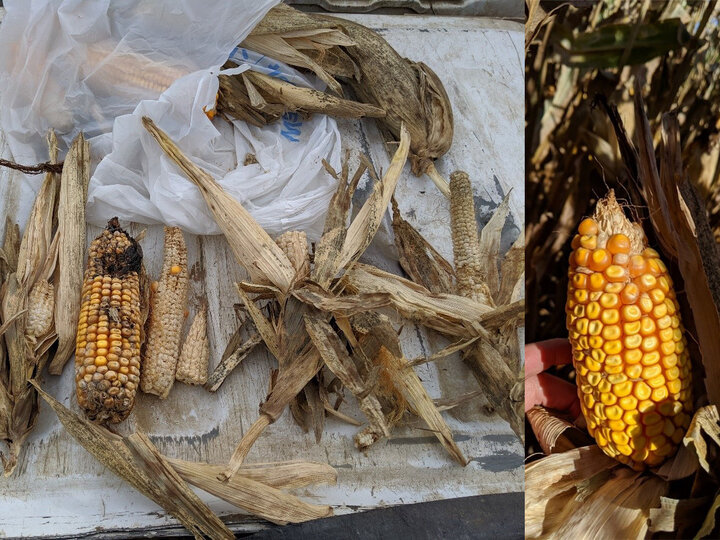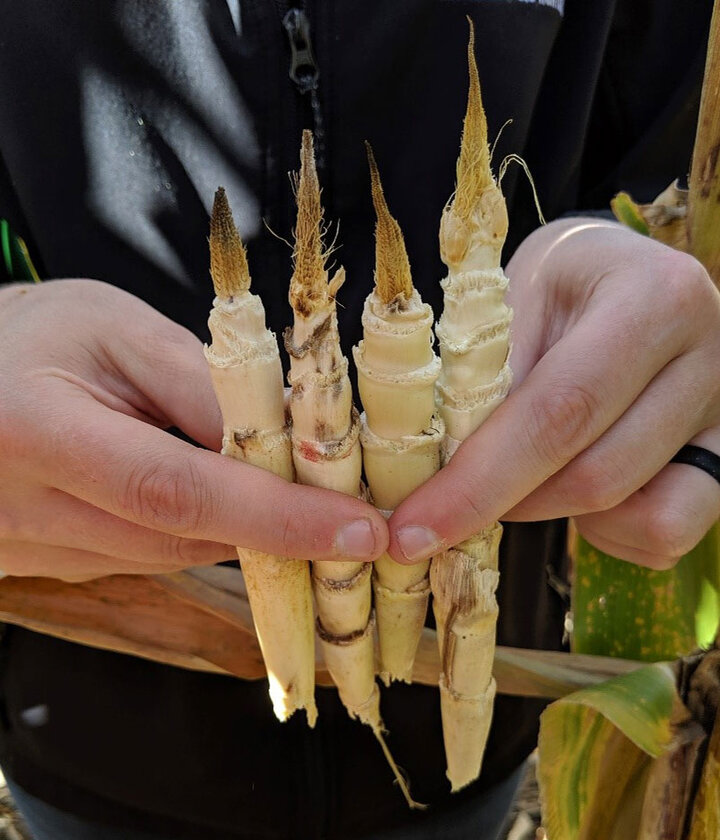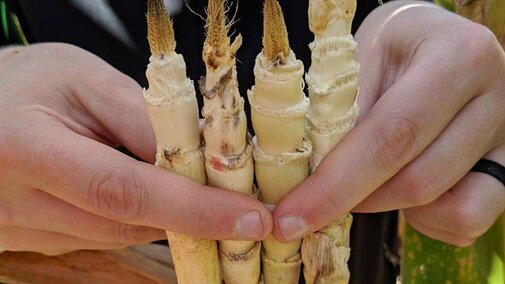Corn ear abnormalities have been noted the past few years. Tracing back the information on various field calls often pointed to a misunderstanding of proper growth stages when making post-emergence herbicide applications in addition to pre-tassel fungicide and insecticide applications. Please see Figures 1 and 2 and this article for more information on proper growth staging of corn.


Development Staging Misunderstandings:
Because some herbicide labels use the ‘plant height method’ of staging, it’s important to understand the role of environment on plant heights. The growth stage that is most restrictive should be followed when both corn leaf stage and height are listed on the label. Warm conditions can lead to rapid plant growth, longer internodes, and taller plants while cooler spring conditions, such as in 2019, lead to shorter plants due to shortened internode lengths. What may look like a V8 (8th leaf stage) plant one year or in one field may be a V10 plant in another field based on height. In 2019, many problematic situations authors were called out to appeared to be in the V8-V10 by plant height when they were actually V11-V13 (due to shortened internode length and splitting stalks). The farmers and/or agronomists were misled (due to shortened internode length. The actual development stage can be determined by splitting stalks).
Another misunderstanding we have encountered is incorrect corn development staging even when stalks are split. There are 4 nodes (from which the first 4 leaves develop) found in the inverted triangle at the stalk base. Those who don’t account for these 4 nodes can mistake a V12 plant for a V8 plant (12-4=8). This makes a large difference in regards to post-emergence herbicide application timing and potential impact to ear development.
Uneven crop emergence in the field can also result in crop injury. Especially as one considers VT fungicide applications, injury has the potential to occur on plants that are behind and in the vegetative stages compared to the majority of plants in the field. Consider applications at full brown silk instead to account for plant-to-plant variation within the field.
Abnormal Observations by Development Stage:
V5-V8: In general, number of rows around for a particular hybrid are determined between V5-V8. In most hybrids, the primary ear shoot initiates around V6 with row number often determined around V7. Iowa State’s “How a Corn Plant Develops” states, “The row number is strongly related to a hybrid’s genetics and impacted only by serious environmental factors such as drought, nutrient deficiencies, and improper herbicide applications.”
We’ve also seen impacts to kernel row number when products were applied in a tank-mix in this time-frame. When combining herbicides, fungicides, insecticides, and nutrient products, it’s important to consider the surfactant load of those products and also any potential antagonism with each other. Sometimes the combination can cause one of the individual products to be “hotter” (stronger) than normal. Particularly applying post-emergence herbicide with fertilizer may result in crop injury. Couple that with various environmental conditions, such as cool/wet, can result in slow growth of the corn plant and a limited ability to metabolize the chemical. To minimize impacts to the crop, it’s best to keep product tank-mix to a minimum. When using a tank mixture, follow the recommendations for the most restrictive label language of the products being used in the tank-mix.
V12+: Beginning at V12 through around a week prior to pollination, number of ovules per row is determined. Stress during this time impacts kernel row length and can cause shortened or arrested ears, depending on stress and timing.
On modern-day hybrids, the primary ear typically develops on node 13 or a node above or below (12 or 14). Stress impacting these nodes can impact primary ear development causing abnormality or abortion. Incorrect timing or use of drop nozzles where the drops hit the “sink”-the kernels on the developing ear-can create absent or various types of arrested ears (Figure 3). If the primary ear is aborted, depending on the situation, sometimes a secondary ear is produced on a lower node which can be normal or arrested.

The use of non-ionic surfactants with various pesticides or pesticide combinations can also create abnormal, absent, or arrested ears. Situations with the presence of only a pointed “primordial tip” extending past the kernels suggests application timing during the V12-V14 timing of ear elongation (Figure 4). Research from Purdue University looked at the impacts of non-ionic surfactants applied with fungicide, insecticide, and/or herbicides and tank-mixtures of these products. They found arrested ear development to occur primarily from V10 to pre-tassel when a non-ionic surfactant was included with a pesticide product. They also found glyphosate + AMS during this time-frame to cause jumbling of the kernels on the ear (Figure 5).


Recommendations:
- Document the development stage of plants via picture or video in each field immediately prior to spraying. Go inside the field past the end rows. We would recommend documenting stage based on nodes and leaf collars by splitting open stalks. Documenting the development stage can aid in assuring correct timing of applications and prevent applications that may result in problems.
- Avoid applying herbicides, fungicides, and/or insecticides with a non-ionic surfactant from V10 to VT to avoid arrested ear development. Be aware that several pesticide products already have surfactants included in the formulation.
- Uneven crop emergence in the field can also result in crop injury. Especially as one considers VT fungicide applications, injury has the potential to occur on plants that are still in the vegetative stages in the field. Consider applications at brown silk instead to account for plant-to-plant variation in the field.
References
Abendroth, L.J., R.W Elmore, M.J. Boyer, and S.K. Marlay. 2011. Corn Growth and Development. Iowa State Univ. Extension Publication #PMR-1009.
Nielsen, R.L, K. Wise, C. and C. Gerber. 2008. Arrested Ears Resulting from Pre-Tassel Applications of Pesticide & Spray Additive Combinations. Purdue University.
Stetzel N, K. Wise, B. Nielsen, and C. Gerber. 2011. Arrested ear development in hybrid corn. Purdue University Extension.

